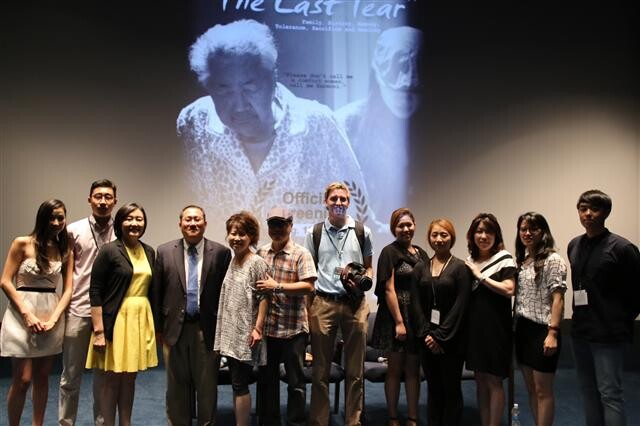hankyoreh
Links to other country sites 다른 나라 사이트 링크
New documentary about a former comfort woman’s “Last Tear”

“I really, really wanted to have a baby, but I couldn’t, right? When I was 34 or so, I took home three babies from the orphanage and raised them.”
Park Suk-i, 94, a former comfort woman living on Namhae Island in South Gyeongsang Province, shared the story of her past calmly, but the sounds of sniffling could be heard from various members of the audience.
On the afternoon of Aug. 15, around two hundred people gathered at the theater of the Naval Memorial in downtown Washington, D.C., for a screening of “The Last Tear,” a documentary about the comfort women.
“The Last Tear” was produced as a joint collaboration between Korean-American director Christopher H.K. Lee, 51, and the US-Korea Institute at SAIS (School of Advanced International Studies) at Johns Hopkins University. It was screened simultaneously in Washington, D.C.; Tokyo and Nanjing and Shanghai in China.
This hour-long documentary begins with an explanation of the comfort women, women who were forced to become sex slaves for the Japanese imperial army, and continues by examining the past pain and present difficulties of the former comfort women, largely through an interview with Park.
Park was abducted by Japanese soldiers when she was 16 while going to dig for clams on the beach in Namhae. For the next seven years, she had to endure the hellish life of a comfort woman in Manchuria, China.
After Korea was liberated from Japan, Park returned home by way of Busan, but there was no one to welcome her. She was unable to get married or to have children.
The documentary does not contain any explicit criticism of the Japanese government, but viewers are strongly encouraged to ask whether Japan has adequately apologized to the women who suffered such pain.
“These days, people are raising a lot of dogs. For a country to be strong, it needs to have a large population. Are dogs going to go fight a war? This country is going to the dogs,” Park says during the documentary, getting a laugh from the audience.
Perhaps in recognition of American affection for their dogs, the documentary pauses at this point to explain that Park‘s attitudes are stuck in 1945.
At certain points during the interview with Park, narration and footage of dancing are used to express the suffering of the comfort women. The dances are performed by a dancer from Latvia, a country that came under colonial occupation twice, just like Korea.
During narration about the Japanese army’s comfort stations, the entire screen goes dark for a time to convey the terror and suffering felt by the comfort women.
After watching the documentary, an office worker named Campbell Baiden described it as “very moving.”
“I was aware that there was some kind of dispute between Korea and Japan, but I only learned about the comfort women issue through seeing this documentary. As the documentary said, I think the comfort women aren’t just an issue for Korea but an issue for the whole world,” Baiden said.
“I never even expected Abe to apologize [in the recent statement]. That’s why the power of the people is important. I‘m going to keep spreading the historical truth about the comfort women issue through this documentary,” Lee, the director, said.
Lee added that he would provide the documentary for free whenever he received a screening request, whether in South Korea or the US.
The documentary premiered in Los Angeles on Aug. 12 and will be screened for the first time in South Korea in Daegu on Aug. 17.
Rep. Park Yeong-seon, who is organizing an exhibition of artwork produced by former comfort women who have undergone art therapy, also attended the screening on Saturday.
By Yi Yong-in, Washington correspondent
Please direct questions or comments to [english@hani.co.kr]

Editorial・opinion
![[Column] Season 2 of special prosecutor probe may be coming to Korea soon [Column] Season 2 of special prosecutor probe may be coming to Korea soon](https://flexible.img.hani.co.kr/flexible/normal/500/300/imgdb/original/2024/0426/3317141030699447.jpg) [Column] Season 2 of special prosecutor probe may be coming to Korea soon
[Column] Season 2 of special prosecutor probe may be coming to Korea soon![[Column] Park Geun-hye déjà vu in Yoon Suk-yeol [Column] Park Geun-hye déjà vu in Yoon Suk-yeol](https://flexible.img.hani.co.kr/flexible/normal/500/300/imgdb/original/2024/0424/651713945113788.jpg) [Column] Park Geun-hye déjà vu in Yoon Suk-yeol
[Column] Park Geun-hye déjà vu in Yoon Suk-yeol- [Editorial] New weight of N. Korea’s nuclear threats makes dialogue all the more urgent
- [Guest essay] The real reason Korea’s new right wants to dub Rhee a founding father
- [Column] ‘Choson’: Is it time we start referring to N. Korea in its own terms?
- [Editorial] Japan’s rewriting of history with Korea has gone too far
- [Column] The president’s questionable capacity for dialogue
- [Column] Are chaebol firms just pizza pies for families to divvy up as they please?
- [Column] Has Korea, too, crossed the Rubicon on China?
- [Correspondent’s column] In Japan’s alliance with US, echoes of its past alliances with UK
Most viewed articles
- 1No good, very bad game for Korea puts it out of Olympics for first time since 1988
- 2Division commander ordered troops to enter raging flood waters before Marine died, survivor says
- 3Korea’s 1.3% growth in Q1 signals ‘textbook’ return to growth, says government
- 4Will NewJeans end up collateral damage in internal feud at K-pop juggernaut Hybe?
- 5[Column] Season 2 of special prosecutor probe may be coming to Korea soon
- 6[Editorial] Korea’s surprise Q1 growth requires objective assessment, not blind fanfare
- 7[Column] ‘Choson’: Is it time we start referring to N. Korea in its own terms?
- 8‘We must say no’: Seoul defense chief on Korean, USFK involvement in hypothetical Taiwan crisis
- 9Korea sees more deaths than births for 52nd consecutive month in February
- 10Is N. Korea threatening to test nukes in response to possible new US-led sanctions body?